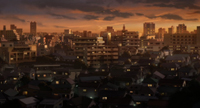




Paprika, the final film of this series, is hand-drawn Japanese animated film that employs computer generated imagery is small portions of the film. This genre of films is the most removed from the physical aspects of film making. Through acute understanding of the details of human movement, motion capture is unnecessary (strange human movements and facial expressions may be part of the stylistic choices a director makes), and all images created are through animation and drawings allowing unlimited possibilities for the creative mind. Though traditionally a Japanese animated film does not use CGI or with very limited uses, there have been increasing trends of employing CGI in Japanese animated films. Much like their live-action counterparts, animated films have delved into the issue of integrating CGI into their environments.
In more recent Japanese animated films, it is hard to spot the difference between hand drawn animation and computer generated animation. This is in part due to the fact that CGI is used subtly and limitedly in some films, but also in part due to the transition towards digital means of hand-drawing. Rather than your traditional drawing boards, animation studios have transitioned towards drawing on computer tablets and editing hand-drawn images on the computer. This allows for a more seamless integration of computer graphics into animation, as hand-drawn images have arguably become computer graphics.
As such, Paprika makes use of 3D modeled environments in many subtle places. It is good to note that human beings or characters are never rendered in 3D models, as hand-drawn characters are one of the hallmarks of Japanese animation. If anything is rendered, it would be everything but the characters. There are exceptions, but most animated films in Japan follow this ideal. With Paprika, it could be argued that the use of computer modeling is not needed to achieve the same effect, however, is needed to save on time computer generated imagery is much more cost effective than hand drawn animations.
Paprika is an example of Japanese animated films that rely purely on animations and the hand-drawn aesthetic that make use of CGI to increase the efficiency of the production of the film. It is unnecessary to use CGI and is frowned upon by more traditional animators. As such, Paprika is similar to Renaissance in that it has a long post production process in which special effects, most notably audio effects (music, voice, noise) is added to create the atmosphere.










